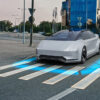6G to V2X – How Digital Twins Enhanced Network Rollouts

Digital twins — virtual models of physical systems like 6G, NTN, and 5G — make it possible to simulate, analyze, and optimize all network systems and components, including their non-terrestrial elements. This is especially useful for accelerating rollouts and identifying bottlenecks and drawbacks before they become real problems.
In this two-part blog series, we will examine how implementing digital twins can benefit network equipment manufacturers and mobile operators and explore its role in R&D acceleration, site deployment automation, spectrum and energy optimization. We will provide use cases, proposed system details, and examples of how VIAVI is implementing and delivering such technology with its partners.
Read part 1 here.
Benefits of digital twins for network operators
In our last blog, we examined the development and rollout of network equipment. In particular, we looked at how digital twins facilitate interoperability and performance validation, while also enabling the identification of potential failures and the modeling of cyberattacks. This capability is especially critical in Open RAN environments, where the disaggregation of radio, distributed, and central units (RU, DU, and CU) introduces more interfaces, significantly expanding the threat surface and complexity of integration.
For mobile network operators, digital twin functionality has some overlap, notably on security, but also have three significant additional functions.
In engineering, planning, and optimization, digital twins enable a virtual-first model to be implemented where network designs and configurations are simulated and tested before the physical implementation. Here, they can be used to identify bottlenecks and optimize the traffic flow on the network to enhance overall performance. Failures can be predicted and fixed before they become problematic.
This capability is especially critical for the evolution toward 6G networks, as it enables testing of emerging technologies and prediction of their real-world behavior. Digital twins provide insights that go beyond isolated components, allowing operators to model the entire network lifecycle, from design and deployment to operation and optimization. This holistic approach supports more effective long-term planning while enhancing connectivity, reliability, and cost-efficiency.
Second is energy usage, a growing concern as the telecom industry faces increasing pressure to reduce its environmental footprint. 6G, with AI/ML-based optimization at its core, is predicted to be more energy efficient than 5G. According to a 2021 IEEE paper, it could require up to 50% lower transmit powers to deliver the same bandwidth/data rate. However, this efficiency gain must be viewed through the lens of Jevons Paradox: as networks become faster and more responsive, user demand tends to rise, potentially offsetting the environmental benefits. To counteract this, digital twins can be used to create real-time views and detect inefficiencies earlier, as well as to optimize processes that are energy intensive and adjust power usage dynamically.
This is achieved through the simulation of network configurations to identify the most efficient design and optimize infrastructure accordingly. We’ll examine this in more detail in our next blog.
Finally, digital twins, and its independent AI engines and data, can also be used to validate the predictions made by AI inference models and are therefore a vital element in automated operation (or the Dark NOC).

Technologies underpinning digital twin networks
Creating a digital twin requires multiple steps, and each one will be (to a greater or lesser extent) unique. However, there are several core elements and steps that need to be implemented.
First on our list is channel modeling using an AI-powered ray tracing tool (VIAVI Air Interface Emulation). This enables channel prediction for 3D environments and supports planning for both indoor and outdoor scenarios. Notably this includes not only coverage, but interference optimization for massive MIMO.
Next is traffic modeling, using the TM500 wireless network tester to emulate several thousands of devices on the network, with system-level RAN behaviors on the digital twin simulated via the TeraVM AI RSG (RAN Scenario Generator).
This AI RSG tool is capable of emulating a huge variety of both topologies and configurations. Mobility patterns and traffic profiles can also be emulated using real and synthetic maps. The resulting real-world data from the channel and traffic modeling is used to train and test the AI engines.
Of course, for the digital twin to provide real, actionable insight, it needs to be a twin of the network as it is… not as it was when created or last updated. To enable this, VIAVI maintains synchronization with the physical network, allowing validation to be performed on an accurate, up-to-date representation of the network state.
More intelligent data can also be gained through tools such as VIAVI’s NITRO Location Intelligence. This can be used to analyze every interaction between subscribers / IoT devices and the network. This contextual information allows for a better understanding of issues and optimization opportunities. And in the digital twin scenario, this tool enables AI analytics for transforming network data into insights.
Taking this one stage further, tools such as NITRO AIOps can enable a more realistic twin, by facilitating the collection and aggregation of huge swathes of data for the twin. All this is before we even think about modeling for specific scenarios such as security or automation.

Good examples of these systems in action can be seen in Europe’s 6G-Twin project, which is implementing reactive and predictive network digital twins to enable tele-operated driving.
These systems create a strong foundation for the design, implementation and validation of an AI-native reference architecture for 6G systems, which are used for improved mobility and energy efficiency.
Digital twin use case examples for network operators
In this section, we’ve briefly outlined two scenarios in which digital twins enable network operators to 1) prevent signaling storms during a DoS attack, and 2) better manage beam management and handover algorithm validation in vehicle (V2X/V2N) communications.
In each, we’ve listed and linked to the tools required for this, with further details listed in our white paper on digital twins.
Preventing signaling storms in DoS/DDoS attacks
Signaling storms – which happen when a network is overwhelmed by excessive control-plane signaling – have been the cause of several major outages. These include significant service outages Telenor, Verizon and NTT DoCoMo that lasted for up to 24 hours.
While signaling storms can happen naturally, control-plane signaling is a vulnerability that can be targeted in DoS/DDoS attacks. This vulnerability needs to be tested in a sandbox environment.
Building such a digital twin to allow a safe attack on the 5G, 6G or IoT network would require three core elements.
The starting point would be an AI RSG (TeraVM AI RAN Scenario Generator) simulating system-level RAN behaviors. Traffic would then need to be modelled, with thousands of devices emulated to create pressure on the digital twin network using the TM500 wireless network tester. Finally, a vRAN emulator would be needed such as the TeraVM-vRAN 5G Emulator, which gives a controllable and repeatable test environment for the implementation of 3GPP standards.
Beam management and handover algorithm validation for V2X/V2N comms
As the automotive industry advances toward large-scale deployment of autonomous vehicles, reliable and ultra-low-latency communication becomes essential for both vehicle-to-vehicle (V2V) and vehicle-to-infrastructure. In this context, latency isn’t just a technical issue; it’s a matter of safety. The success of V2X (vehicle-to-everything) communications will rely heavily on the capabilities of 6G networks, particularly in reducing latency and supporting advanced beam management and seamless handovers.
These technologies must undergo rigorous testing and validation before being deployed in 1.5- to 2-ton autonomous vehicles operating in environments shared with pedestrians and cyclists. Understanding interference patterns and minimizing inter-user interference are critical. System-level RAN behaviors need to be accurately simulated – ideally using AI-driven Radio Scenario Generators (RSGs) – to predict real-world performance. Ray tracing techniques can enhance these simulations by emulating dynamic environments, including moving vehicles, pedestrians, cyclists, buildings, and road infrastructure.
Evolving digital twin solutions
VIAVI offers a flexible and scalable solution for digital twins that enables the selection of either individual components or complete RAN-to-Core digital twin.
The company has a long history of providing solutions across lab, field, and operations, and with a leading R&D team, can help you demonstrate the accuracy and value of network equipment.
For more information on our digital twin solutions, download our white paper.



